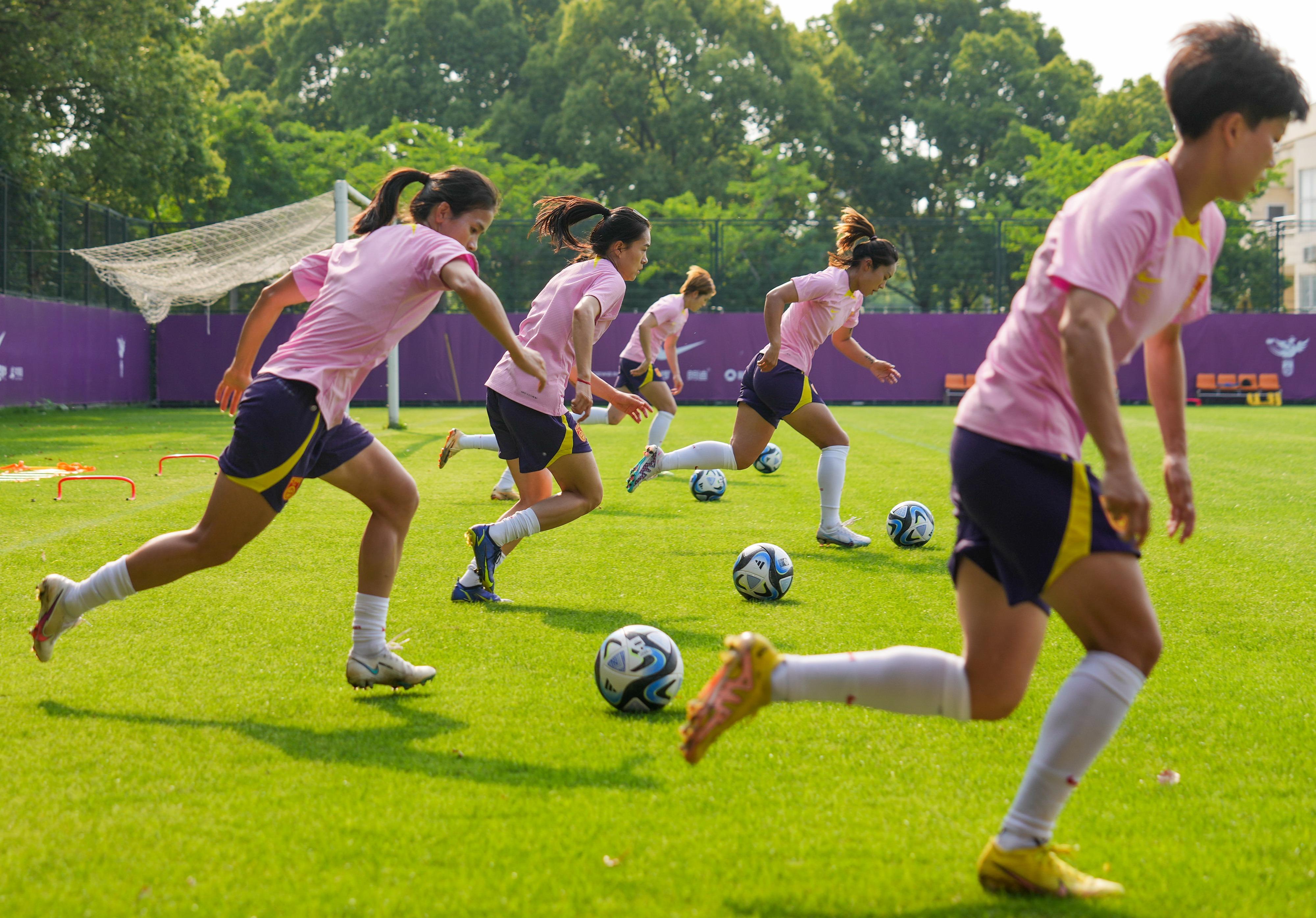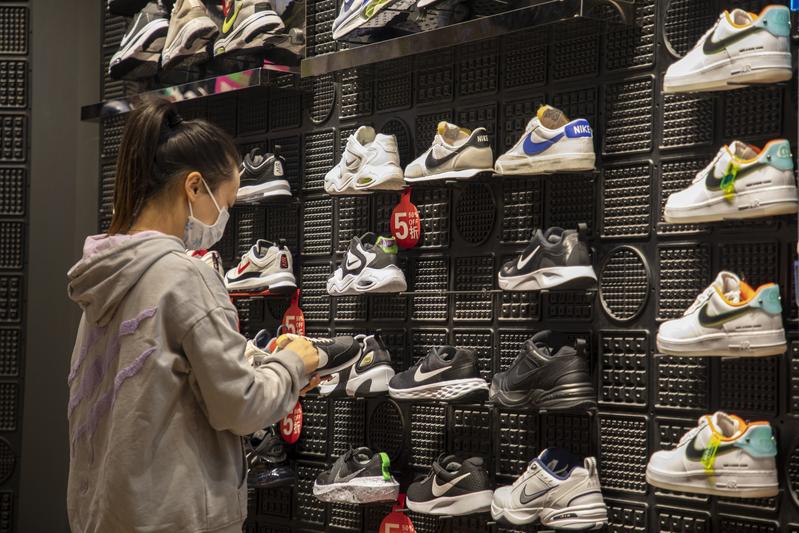Brands cash in on women’s demand for eye-catching exercise routines, fitness products
 Members of the Chinese national women's soccer team train in Shanghai in May. (PHOTO / XINHUA)
Members of the Chinese national women's soccer team train in Shanghai in May. (PHOTO / XINHUA)
Full of youthful energy, Hu Rongfeng is a sociology senior at a top university in Beijing who can bust some killer jazz dance moves as well as urban dance styles from the likes of K-pop girl bands.
Her rise to prominence was sparked by a street dance short video she uploaded on a social media platform.
In the video, Hu and a friend in the street dance community showcased seamless moves and spearheaded efforts to make street dance a mainstream activity on campus.
In 2020, the crew seized an opportunity to perform at the university’s basketball finals.
“It was a major success. Students loved us. We’ve since become regulars at all the other sports games in the university,” recalled Hu.
The popularity of K-pop and hip-hop music, along with related choreography that allows each dancer to be the center of attention, has contributed to their increasing popularity on campus.
Hu, who has long dyed hair, wears loose sweaters and Nike Air Force 1 sneakers, attributes the allure of street dancing to its strong sense of belonging and also being a good form of exercise.
“One does not need to be athletic to learn street dance. You can start from scratch and still be able to nail it. Various sports have become part of daily life in universities, such as flying discs, street dancing or roller-blading,” she added.
Nowadays, more young women exercise to stay in top shape and sometimes to show off some killer dance moves online rather than simply to lose weight, she said.
Hu is one of a growing number of young Chinese women who have embraced emerging sports activities for both exercise and socializing.
Sarah Shao, a veteran coach at a gym chain in Beijing, said that over the past three years, more women have been paying attention to their well-being and health, encouraged by the flood of information from social media and experiences from their peers.
Training including boxing, yoga, weightlifting, and balance and stability drills have become the most popular, Shao said.
“Girls come to gyms to look and feel better about themselves. They consider fitness training as a good investment and a healthy lifestyle,” she said.
According to a women’s fitness report released by Leoao — a Hangzhou, Zhejiang province-based gym chain with more than 1,000 branches nationwide — women account for 54 percent of the gym chain’s total members.
Participation of females is higher in Beijing, followed by Changsha, Hunan province, and Shanghai, with workout enthusiasts hitting the gym three to four times a week. They spend an hour on average working up a sweat.
A report by McKinsey & Company said there has been a rise in demand from Chinese women for sports and fitness products, with women nationwide spending 15-20 percent more on these items than men.
Recognizing this trend, US-based sportswear giant Nike Inc has significantly increased its investment in the female physical fitness sector, committing itself to innovative products and services to serve the Chinese market.
In fiscal year 2022, revenue generated from Nike’s women’s lines reached $8.27 billion globally, though this was still less than a third of the brand’s total revenue.
 A customer checks out Nike sneakers at an outlet in Shanghai in October 2021. (PHOTO PROVIDED TO CHINA DAILY)
A customer checks out Nike sneakers at an outlet in Shanghai in October 2021. (PHOTO PROVIDED TO CHINA DAILY)
In research and development, Nike has added resources to its research labs to focus on women-centric sports science and doubled the volume of sports science targeting females, while expanding cooperation with top female athletes in China, including the country’s national women’s soccer team, this year.
From running to yoga, Nike has established a wide network with more than 300 sports communities throughout the country, serving more than 100,000 consumers annually, the company said.
During this year’s International Women’s Day on March 8, the company organized over 130 community activities in China, including healing concerts, sound yoga, fragrance experiences and muscle tone training in 26 stores.
With nearly 1,800 retail experts providing personal services to consumers every day, Nike has 400 fashion experts who cater to customers in more than 100 stores across 30 cities.
Online, Nike has expanded its digital ecosystem, with self-owned platforms that have a higher proportion of female consumers.
On Nike’s WeChat mini program, female users account for 53 percent of the total and the number is growing, according to the company.
“We have observed that female consumers often care more about expressing their personal styles while meeting performance needs,” said Eric Wei, vice-president and general manager of Nike Women Greater China.
For instance, eyeing the trend among female sports lovers for fashionable tops and leggings in China, the company has introduced a brand-new feature called “Bra and Legging Finder” on its digital platforms such as the Nike App and Nike WeChat mini program.
The feature is tailored to the needs of female consumers and their demand for yoga products, creating a personalized and all-around sporty style space.
Offline, the one-stop shopping site in retail stores has expanded the space of the tops and leggings sector, allowing it to stand out in retail venues and make it easier for consumers to find their colors and sizes, said the company.
Nike is among a cluster of sportswear brands — international or domestic — to enhance investment in women’s athletic wear and gear in the Chinese market.
The reasons for the shift of focus from products dominated by male consumers are the rising awareness of female participants in sports and the desire to share favorite exercise experiences online, said Adam Zhang, founder of Key-Solution Sports Consulting.
The “she sports” trend has been on the rise in the Chinese sportswear and fitness market, propelled by rising purchasing power among female consumers and emerging awareness among Chinese women regarding health and wellness through exercise and sporting activities, Zhang said.
“Sports and fitness have become a social currency among middle-income earners in China. And women have earned more attention from sportswear producers and brands,” he said.
Social media that serve as platforms for women to share their favorite sports and increasingly fit physiques during workouts have played a vital role in extending the scale of female sports and related products, he added.
Innovations in the sportswear and fitness sectors have mushroomed in recent years — especially products and services designed and developed for women, rather than adaptations from men’s products.
For example, there are some gyms tailored for female customers where women can have more female-friendly services and equipment and store designs that aim to please female aesthetics, Zhang said.
Connecting with female exercise enthusiasts is of huge importance to sportswear brands in their marketing campaigns.
“For women, they want to learn more about how they feel about the design and function when they try it on, rather than directly being offered information about performance and function,” said Zhang.
Brands should continue to strengthen innovations that take into consideration female physiques when developing product features such as color, material and style. But the key to developing a winning product is understanding women, Zhang said.
“Being a listener and confidant for women and knowing their community will help to loosen fixed mindsets and bring more breakthrough products,” he said.


